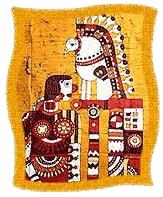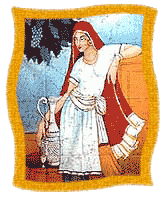





...Batik Paintings...
Originated
in India, the art of batik has come a long way from a mere handicraft. The
word batik
actually means 'wax writing'. It is a way of decorating cloth by covering
a part of it with a coat of wax and then dyeing the cloth. The waxed areas
keep their original color and when the wax is removed the contrast between
the dyed and undyed areas makes the pattern.
batik
actually means 'wax writing'. It is a way of decorating cloth by covering
a part of it with a coat of wax and then dyeing the cloth. The waxed areas
keep their original color and when the wax is removed the contrast between
the dyed and undyed areas makes the pattern.
In the past, batik was considered as a fitting occupation for aristocratic ladies whose delicately painted designs based on bird and flower motifs were a sign of cultivation and refinement just as fine needlework was for European ladies of similar position.
The beauty of batik lies in its simplicity and the fact that one need not be an artist to achieve results. Some of the best effects in batik are often achieved by chance.
History
Batik is very often considered a craft like ceramic, pottery or even needlework.
Although it is a household word all over the world, batik is still overlooked
by art critics who do not consider it an art form. There are several countries
known for their batik creations, starting with India where it originated.
After that it moved to Indonesia, Malaysia, Sri Lanka, Thailand and the West.
The history of Indian batik can be traced as far back as 2000 years. Indians were conversant with the resist method of printing designs on cotton fabrics long before any other nation had even tried it. Rice starch, and wax were initially used for printing on fabrics.
India has always been noted for its cotton and dyes. The indigo blue, which is the basic color for batik, is one of the earliest dyes. It is believed that after its initial popularity in the past, the tedious process of dyeing and waxing caused the decline of batik in India till recent times.
The
Process Involved
 The
creation of batik is a three-stage process of waxing, dyeing and dewaxing
(removing the wax). There are also several sub-processes like preparing the
cloth, tracing the designs, stretching the cloth on the frame, waxing the
area of the cloth that does not need dyeing, preparing the dye, dipping the
cloth in dye, boiling the cloth to remove wax and washing the cloth in soap.
The
creation of batik is a three-stage process of waxing, dyeing and dewaxing
(removing the wax). There are also several sub-processes like preparing the
cloth, tracing the designs, stretching the cloth on the frame, waxing the
area of the cloth that does not need dyeing, preparing the dye, dipping the
cloth in dye, boiling the cloth to remove wax and washing the cloth in soap.
The characteristic effects of the batik are the fine cracks that appears in the wax, which allow small amounts of the dye to seep in. It is a feature not possible in any other form of printing. It is very important to achieve the right type of cracks or hairline detail for which the cloth must be crumpled correctly. This requires a lot of practice and patience.
Knowing how to use the wax is of prime importance. The ideal mixture for batik wax is 30 per cent beeswax and 70 per cent paraffin wax. For first timers even the melted wax of a candle is adequate. It is the skillful cracking that is important. While applying, the wax should not be overheated or it will catch fire. Correct knowledge of colors is also important. Practicing on small pieces of cloth helps in the beginning. Patience is of course a very important factor too.
The cloth used should be strong enough to bear the heat and wax. Cambric, poplin and voiles are used besides pure silk. Synthetic fabrics should be avoided. Since ancient times Indians have been known to wear vibrant colors and dyes which were made from barks of trees, leaves, flowers and minerals. Blue was obtained from indigo, while orange and red were from henna. Yellow was from turmeric and lilac and mauve from logwood. Black was created by burning iron in molasses and cochineal from insects.
Since handmade batik is unable to meet with the consumer demands very often the answer is tjaping with a copper block. A tjap is a metal block made of copper strips into the required design after which it is stamped quickly and with great force.

Various Types And Forms
Batik is created in several ways. In splash method the wax is splashed or
poured onto the cloth. The screen-printing method involves a stencil. The
hand painting one is by a Kalamkari pen. The scratch and starch resist are
the other methods.
From
a handicraft, batik has acquired the status of an art. Batik is a versatile
medium that can become an ideal hobby for an amateur or a medium of expression
for an artist. Batik as an art form is quite spontaneous and one can open
up new vistas of creative form. Until recently batik was made for dresses
and tailored garments only but modern batik is livelier and brighter in the
form of murals, wall hangings, paintings, household linen, and scarves.
|
Best
viewed in Internet Explorer 5+ at a screen resolution of 1024 by 768
Pixels
Web-Site designed & maintained by WEB
SOLUTIONS
|